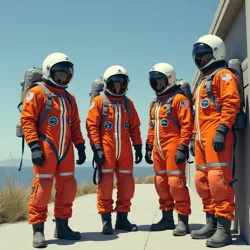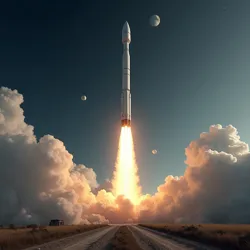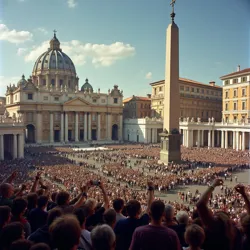Italian Lunar Achievement: The 1990 Missione Luna Landing
 Members of the Missione Luna crew during final preparations at the Sardinia Space Center
Members of the Missione Luna crew during final preparations at the Sardinia Space CenterOverview
The successful Italian lunar landing on January 1st, 1990, marked a significant milestone in human space exploration, making the Kingdom of Italy the sixth nation to achieve this feat. The mission, designated Missione Luna, represented the culmination of decades of Italian aerospace development and highlighted the nation's technological resurgence under the National Space Program Initiative established in 1975.
Historical Context
The Italian space program emerged from a complex web of political and technological ambitions following the Second World War. While initially lagging behind other major powers, Italy's fascist government under the Reformed Grand Council viewed space exploration as a means to demonstrate national prestige and technological capability. The success of the German Reich's Mondflug-1 mission in 1962, followed by achievements by the United States, Japan, China, and India, created mounting pressure within Italian political circles to develop comparable capabilities.
The Mediterranean Aerospace Corporation, founded in 1970, served as the primary vehicle for Italy's space ambitions. Operating from the purpose-built Sardinia Space Center, the program benefited from collaboration with Spanish aerospace engineers, particularly in rocket propulsion technology. This partnership proved crucial in developing the Aquila-V launch vehicle used in the successful mission.
Mission Development
 The Aquila-V rocket carrying the Luna capsule lifts off from the Sardinia Space Center
The Aquila-V rocket carrying the Luna capsule lifts off from the Sardinia Space CenterThe Missione Luna utilized a three-stage approach similar to other successful lunar missions. The Aquila-V rocket, powered by the revolutionary Vulcano Engine System, provided the initial thrust. The mission's unique feature was the Mediterranean Orbital Interface, a specialized docking system developed through Italian-Spanish cooperation.
The crew consisted of three members:
-
Commander Giuseppe Ferraro, veteran of three orbital missions
-
Pilot Antonio Rossi, spacecraft systems specialist
-
Navigation Officer Carlos Rodriguez, Spanish aerospace expert
The inclusion of Rodriguez represented the deepening technological partnership between Italy and Spain, formalized under the Mediterranean Space Cooperation Treaty of 1985.
The Landing
The lunar landing occurred at 03:47 UTC on January 1st, 1990, in the Mare Tranquillitatis region. Commander Ferraro's first words upon stepping onto the lunar surface were "Per l'Italia e per l'umanità" (For Italy and for humanity), carefully chosen to reflect both national pride and international cooperation. The crew conducted several experiments, including the deployment of the Galileo Seismic Array, which continued to transmit data until 1997.
Technological Achievements
The mission showcased several Italian technological innovations, including the Dante Navigation System, which provided unprecedented landing precision. The Leonardo Life Support Module, developed in Turin, introduced new recycling technologies that influenced later space station designs. These achievements demonstrated Italy's ability to contribute unique solutions to space exploration challenges.
International Reactions
The successful mission generated varied responses from global powers. The Organization of Free Nations (OFN) officially congratulated Italy, though some members expressed concern about the mission's military implications. The Einheitspakt response was notably warm, with the German Reich proposing increased space cooperation through the European Space Initiative.
The Soviet Union's reaction was measured, acknowledging the achievement while emphasizing their own space program's priorities. The Co-Prosperity Sphere, led by Japan, viewed the mission as further evidence of Western technological advancement, prompting increased funding for their own space initiatives.
ASEAN's response was particularly significant, with both China and India proposing new technological exchange programs. The Bangkok Space Summit of 1990 was organized partly in response to Italy's achievement, leading to increased regional cooperation in space exploration.
Domestic Impact
 Crowds gathering in St. Peter's Square to celebrate the successful mission
Crowds gathering in St. Peter's Square to celebrate the successful missionWithin Italy, the successful mission generated unprecedented public enthusiasm. The National Technology Festival of 1990 drew millions of visitors, while enrollment in aerospace engineering programs doubled the following academic year. The mission's success also strengthened the position of the Reformed Grand Council, which had faced criticism over the program's cost.
The economic impact was substantial, with the Mediterranean Industrial Complex experiencing significant growth. The success led to the establishment of the Advanced Technologies Initiative, which promoted the application of space-derived technologies in civilian industries.
Legacy
The 1990 lunar landing established Italy as a major player in space exploration. The mission's technological innovations, particularly in life support and navigation systems, influenced subsequent international space efforts. The Mediterranean Space Cooperation Framework, established in 1991, became a model for regional space collaboration.
The success also led to increased funding for the Italian Aerospace Academy, which has since trained astronauts from multiple nations. The mission's scientific data, particularly from the Galileo Seismic Array, contributed significantly to lunar geology research and influenced the planning of later missions by other nations.
The landing site, now known as Sito Ferraro, has been designated as a historical landmark by the International Space Heritage Committee. The mission's documentation and artifacts are preserved at the National Space Museum in Rome, where they continue to inspire new generations of Italian scientists and engineers.